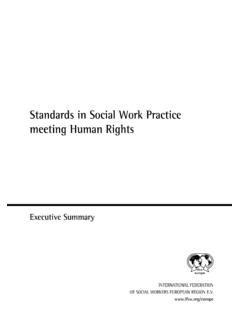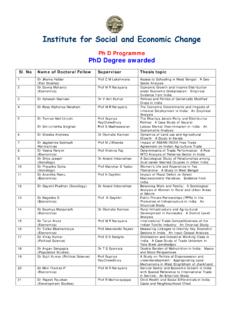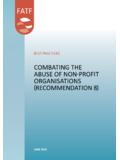Transcription of RISK OF TERRORIST ABUSE IN NON-PROFIT …
1 FATF REPORTRisk of TERRORIST ABUSE in NON-PROFIT OrganisationsJune 2014 FINANCIAL ACTION TASK FORCE The Financial Action Task Force (FATF) is an independent inter-governmental body that develops and promotes policies to protect the global financial system against money laundering, TERRORIST financing and the financing of proliferation of weapons of mass destruction. The FATF Recommendations are recognised as the global anti-money laundering (AML) and counter- TERRORIST financing (CFT) standard.
2 For more information about the FATF, please visit the website: 2014 FATF/OECD. All rights reserved. No reproduction or translation of this publication may be made without prior written permission. Applications for such permission, for all or part of this publication, should be made to the FATF Secretariat, 2 rue Andr Pascal 75775 Paris Cedex 16, France (fax: +33 1 44 30 61 37 or e-mail: Photocredits coverphoto: Thinkstock RISK OF TERRORIST ABUSE IN NON-PROFIT ORGANISATIONS 2014 i CONTENTS GLOSSARY OF TERMS AND ACRONYMS.)
3 III EXECUTIVE SUMMARY .. 1 Understanding the Risk .. 2 Scope of the Project .. 3 Nature of the Threat .. 3 Mitigating the Risk .. 4 Categories of Risk .. 5 Detection and Disruption .. 6 Indicators .. 7 Next Steps .. 7 CHAPTER 1 INTRODUCTION .. 8 Background .. 8 Scope and objectives .. 9 The Terrorism Support Continuum .. 12 Terrorism Financing versus Money Laundering: Methods and risks .. 13 Data Collection and Sources .. 14 Collection of Case Studies .. 15 Collection of General Jurisdictional Data.
4 16 NPO Sector Questionnaires and Workshops .. 16 Open-Source Research .. 17 CHAPTER 2 THE NPO SECTOR AND THE RISK OF TERRORIST ABUSE .. 18 The Global Environment .. 18 The NON-PROFIT 20 NPO Sector Operations and Vulnerabilities .. 23 The Current Nature of the TERRORIST Threat .. 26 TERRORIST ABUSE and the Risk to NPOs .. 28 Strategic Issues .. 32 Issue 1 A Tension Created by Equally Necessary Imperatives .. 32 Issue 2 National Responses to International 33 Conclusion .. 34 CHAPTER 3 METHODS AND RISK OF ABUSE .
5 36 Diversion of Funds .. 37 Diversion of Funds by Actors Internal to NPOs .. 38 Diversion of Funds by Actors External to NPOs .. 41 Affiliation with a TERRORIST Entity .. 42 ABUSE of Programming .. 44 Support for Recruitment .. 45 False Representation and Sham NPOs .. 47 RISK OF TERRORIST ABUSE IN NON-PROFIT ORGANISATIONS ii 2014 CHAPTER 4 METHODS OF DETECTION .. 49 NPO Regulatory Information .. 51 Open Source Information .. 52 FIU and Other Financial 53 National Security Intelligence .. 54 Law Enforcement Information.
6 55 Foreign Cooperation and Information .. 55 Conclusion .. 57 CHAPTER 5 METHODS OF DISRUPTION .. 58 Sector Outreach, Education, and Self-regulation .. 59 Criminal Prosecution .. 59 Administrative Enforcement, Penalties, and Targeted Sanctions .. 61 Conclusion .. 64 CHAPTER 6 RISK INDICATORS AND TERRORIST ABUSE INDICATORS .. 65 The Nature of Indicators .. 65 Indicator Categories .. 68 Category 1: Financial Support to Known or Suspected TERRORIST Entities .. 68 Category 2: Material Support to Known or Suspected TERRORIST Entities.
7 69 Category 3: Financial, Material, or Logistical Support to Proscribed TERRORIST Entities .. 69 Category 4: Operations in Areas Where There are Active TERRORIST Threats .. 70 Category 5: General Operations and Governance .. 71 Category 6: Support for Recruitment .. 72 Category 7: Other Criminal Activities .. 72 CHAPTER 7 CONCLUSION .. 74 Strategic Considerations .. 75 Analytic Findings .. 76 Future Work .. 80 BIBLIOGRAPHY .. 81 APPENDIX A CASE STUDIES .. 87 RISK OF TERRORIST ABUSE IN NON-PROFIT ORGANISATIONS 2014 iii GLOSSARY OF TERMS AND ACRONYMS Note: For the purposes of consistency, all currencies in this report have been converted to US dollars (USD).
8 Active recruitment: The recruitment of individuals by a TERRORIST movement through direct interaction with those individuals. (This type of recruitment is akin to talent-spotting. ) APG: Asia/Pacific Group on Money Laundering. Capability: The operational capacity of a TERRORIST group to carry out its objectives. A threat is dependent on actors that possess both the capability and the intent to do harm, in this case towards the NPO sector. AML: Anti-money laundering CFT: Countering the financing of terrorism.
9 CT: Counter-terrorism Detection: Any action, or series of actions, on the part of government or non-governmental actors that leads to the discovery of activity that could benefit TERRORIST entities. In the context of this report, this often involves the collection and analysis of different types of information. Directing official: An individual who holds a leadership position in an NPO and has the ability to direct aspects of the NPO s activities.
10 This includes directors, officers, trustees, and religious leaders. Disruption: Any action taken by a government or non-governmental actor to interrupt activity that could benefit TERRORIST entities. DNFBP: Designated Non-financial Business or Profession. Dual-use equipment: Equipment that has both peaceful and military applications, depending on intent. EFT: Electronic funds transfer. Expressive NPO: NON-PROFIT organisations predominantly involved in expressive activities, which include programmes focused on sports and recreation, arts and culture, interest representation, and advocacy.
















